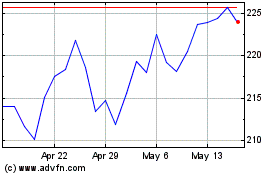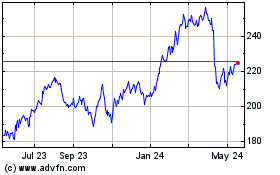Households continue to slowly climb out of the
pandemic-era financial hole caused by inflation
Primerica, Inc. (NYSE: PRI), a leading provider of financial
services and products in the United States and Canada, released its
Financial Security Monitor™ (FSM™) survey for the third quarter of
2024, revealing that a majority of middle-income Americans are
feeling increasingly pessimistic about their personal finances, the
economic health of their communities and their ability to save for
the future.
This press release features multimedia. View
the full release here:
https://www.businesswire.com/news/home/20241008472706/en/
Primerica Household Budget Index™ -
Spending power reached its highest level since February 2021 in
August 2024. The average purchasing power for middle-income
families was 102.2% in August, up from 101.5% in July 2024 and 5%
higher than a year ago when the index stood at 97.2%. (Graphic:
Business Wire)
“For the first time in a year, a majority of middle-income
households are feeling negative about their personal finances. In
fact, this latest report represents the highest negative rating
we’ve seen since we began fielding the survey exactly four years
ago,” said Glenn Williams, CEO of Primerica. “Families continue to
list inflation as their No. 1 concern, with the stress it brings
spilling over into worry about being able to afford everyday
essentials like food or groceries and going to the doctor as well
as managing their rising credit card debt.”
In contrast, Primerica’s latest Household Budget Index™ (HBI™)
indicates middle-income households experienced an uptick in
purchasing power in August 2024 with the index climbing to 102.2%,
up from 97.2% a year ago. The latest figure is positive news for
middle-income families, signaling a greater ability to afford
everyday expenses like food, gas, utilities and health care.
However, the deep hole high inflation dug in their finances during
the pandemic means they’re simply not feeling the full effect of
these gains yet.
“The economy has turned more favorable in recent months, but it
will take time for the effects of lower interest rates, declining
prices on necessities and rising wages to have a real impact on the
bottom lines of middle-income families,” said Amy Crews Cutts,
Ph.D., CBE®, economic consultant to Primerica. “The financial
challenges these households are grappling with are poised to
persist through the end of this year — and likely beyond. It's
clear this is a marathon, not a sprint."
Key Findings from Primerica’s Q3 U.S. Middle-Income Financial
Security Monitor™ (FSM™)
- Middle-income Americans’ perceptions of their personal and
community financial health continue to decline. A majority of
households (55%) now rate their personal financial situation
negatively — a 6-point increase from the previous survey.
Significant majorities also view the economic health beyond just
their own personal finances in a grim light – their community (63%
negative, up 5 points), the nation (73% negative, up 1 point), and
their ability to save for the future (73% negative, up 5
points).
- Credit card debt — and concern over it — is rising. More
than one-third (35%) of middle-income Americans say their credit
card debt has risen in the past three months — a 5-point jump from
the previous survey — and less than one-third (31%) are paying off
their credit card in full each month. In addition, nearly half
(44%) are more worried about their credit card debt than they were
a year ago — a 9-point jump from the last survey and the highest
level of concern since the question was first introduced in March
2023. Still, more than two-thirds (69%) say they have reduced
overall spending in the past couple years.
- Uncertainty over the country’s economic future is running
high. The share of households expecting the American economy to
worsen in the next year has dropped significantly, with just 25%
holding that view — down 15 points from the previous survey.
However, much of the shift is driven by growing uncertainty, as
one-third (34%) of respondents — up 15 points — are unsure about
the economy’s direction. Still, optimism also ticked up, with 25%
now believing the economy will improve over the next year, a
7-point increase.
- Inflation, paying for food or groceries are stressing
families out. Inflation remains the No. 1 concern for
middle-income Americans, with over one-third (40%) citing it as a
major worry — an 8-point increase since the last survey. Close
behind, one-third (33%) now rank paying for food and groceries as
their second biggest concern, up 7 points. Moreover, when asked to
describe their feelings about their finances, a majority (58%)
chose “stressed,” while nearly half (43%) selected
“discouraged.”
- Half of middle-income Americans can’t afford to go to the
doctor. When asked to choose what they could afford from a
list, only half (51%) said they could cover the cost of a doctor’s
visit — a disconcerting figure given that more than a quarter (27%)
expressed concern about their health or getting sick, making it the
third top worry for these households.
Primerica Financial Security Monitor™ (FSM™) Topline Trends
Data
Sept 2024
Jun 2024
Mar 2024
Dec 2023
Sept 2023
Jun 2023
Mar 2023
Dec 2022
Sept 2022
How would you rate the condition of
your personal finances? Share reporting “Excellent” or
“Good.”
44%
49%
50%
50%
49%
50%
52%
53%
53%
Analysis: Respondents are increasingly
negative in their assessment of their personal finances.
Overall, would you say your income
is…?
Share reporting “Falling behind the
cost of living”
68%
66%
67%
68%
72%
71%
72%
72%
75%
Share reporting “Stayed about even with
the cost of living”
24%
26%
25%
24%
20%
22%
21%
20%
19%
Analysis: Concern about meeting the
increased cost of living remained steady with 92% noting an
inability to get ahead.
And in the next year, do you think the
American economy will be…?
Share reporting “Worse off than it is
now”
25%
40%
46%
53%
56%
57%
53%
56%
51%
Share reporting “Uncertain”
34%
19%
18%
9%
9%
9%
7%
8%
8%
Analysis: While fewer respondents think
the economy will definitely get worse over the next year, the
rising share that are uncertain about its direction accounts for
most of the change.
Do you have an emergency fund that
would cover an expense of $1,000 or more (for example, if your car
broke down or you had a large medical bill)? (Reporting “Yes”
responses.)
61%
63%
62%
60%
62%
61%
58%
59%
60%
Analysis: The percentage of Americans
who have an emergency fund that would cover an expense of $1,000 or
more has remained steady over the past year.
How would you rate the economic health
of your community? (Reporting “Not so good” and “Poor”
responses.)
63%
58%
60%
57%
55%
54%
59%
53%
55%
Analysis: Respondents’ rating of the
economic health of their communities has gotten worse over the past
year.
How would you rate your ability to save
for the future? (Reporting “Not so good” and “Poor”
responses.)
73%
68%
67%
73%
71%
71%
73%
74%
73%
Analysis: A significant majority
continue to feel it is difficult to save for the future.
In the past three months, has your
credit card debt…? (Reporting “Increased” responses.)
35%
30%
34%
35%
34%
33%
33%
39%
37%
Analysis: Credit card debt has remained
about the same over the past year.
About Primerica’s Middle-Income Financial Security Monitor™
(FSM™)
Since September 2020, the Primerica Financial Security Monitor™
has surveyed middle-income households quarterly to gain a clear
picture of their financial situation, and it coincides with the
release of the monthly HBI™ four times annually. Polling was
conducted online from September 10-13, 2024. Using Dynamic Online
Sampling, Change Research polled 999 adults nationwide with incomes
between $30,000 and $130,000. Post-stratification weights were made
on gender, age, race, education and Census region to reflect the
population of these adults based on the five-year averages in the
2021 American Community Survey, published by the U.S. Census. The
margin of error is 3.4%. For more information visit
Primerica.com/public/financial-security-monitor.html.
About the Primerica Household Budget Index™ (HBI™)
The Primerica Household Budget Index™ (HBI™) is constructed
monthly on behalf of Primerica by its chief economic consultant Amy
Crews Cutts, PhD, CBE®. The index measures the purchasing power of
middle-income families with household incomes from $30,000 to
$130,000 and is developed using data from the U.S. Bureau of Labor
Statistics, the US Bureau of the Census, and the Federal Reserve
Bank of Kansas City. The index looks at the cost of necessities
including food, gas, utilities, and health care and earned income
to track differences in inflation and wage growth.
The HBI™ is presented as a percentage. If the index is above
100%, the purchasing power of middle-income families is stronger
than in the baseline period and they may have extra money left over
at the end of the month that can be applied to things like
entertainment, extra savings, or debt reduction. If it is under
100%, households may have to reduce overall spending to levels
below budget, reduce their savings or increase debt to cover
expenses. The HBI™ uses January 2019 as its baseline. This point in
time reflects a recent “normal” economic time prior to the COVID-19
pandemic.
Periodically, prior HBI™ values may be revised due to revisions
in the CPI series and Consumer Expenditure Survey releases by the
U.S. Bureau of Labor Statistics (BLS). Beginning with the October
2023 release of the HBI™ data, health insurance costs will no
longer be included in the calculation of the HBI™ data as part of
the healthcare component because of some newly acknowledged
methodology that has been used by the BLS to calculate the health
insurance CPI. The health insurance CPI, as calculated by BLS, does
not measure consumer costs of health insurance such as the cost of
premiums paid or a combination of premiums and deductibles, but
rather premium values retained by health insurers we do not believe
it accurately reflects consumer experiences. The healthcare
component will continue to include medical services, prescription
drugs and equipment. Prior published values have been adjusted to
reflect this change. For more information visit
householdbudgetindex.com.
About Primerica, Inc.
Primerica, Inc., headquartered in Duluth, GA, is a leading
provider of financial products and services to middle-income
households in North America. Independent licensed representatives
educate Primerica clients about how to better prepare for a more
secure financial future by assessing their needs and providing
appropriate solutions through term life insurance, which we
underwrite, and mutual funds, annuities and other financial
products, which we distribute primarily on behalf of third parties.
We insured approximately 5.7 million lives and had approximately
2.9 million client investment accounts on December 31, 2023.
Primerica, through its insurance company subsidiaries, was the #2
issuer of Term Life insurance coverage in the United States and
Canada in 2023. Primerica stock is included in the S&P MidCap
400 and the Russell 1000 stock indices and is traded on The New
York Stock Exchange under the symbol “PRI”.
View source
version on businesswire.com: https://www.businesswire.com/news/home/20241008472706/en/
Public Relations Gana Ahn, 678-431-9266
gana.ahn@primerica.com
Investor Relations Nicole Russell, 470-564-6663
nicole.russell@primerica.com
Primerica (NYSE:PRI)
Historical Stock Chart
From Dec 2024 to Jan 2025

Primerica (NYSE:PRI)
Historical Stock Chart
From Jan 2024 to Jan 2025
